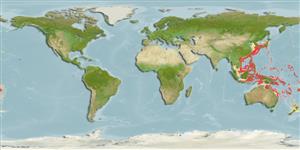Environment: milieu / climate zone / depth range / distribution range
বাস্তুসংস্থান
সামুদ্রিক তলদেশ বিহারী; গভীরতার পরিসীমা 60 - 400 m (Ref. 9792). Deep-water
Northwest Pacific: Japan, Taiwan, and China near Hainan. Reported from the Philippines (Ref. 11148) and South Korea (Ref. 77001).
আকৃতি / ওজন / Age
Maturity: Lm ? range ? - ? cm
Max length : 19.0 cm TL পুরুষ/ লিঙ্গ অনিধর্ারিত ; (Ref. 9792)
Upper-jaw length 3.4 to 3.9 times in head length (Ref 12933).
Found on sand-mud bottoms. Very rare. Feeds on small benthic animals (Ref. 9792).
Life cycle and mating behavior
Maturities | প্রজনন | Spawnings | Egg(s) | Fecundities | শুককীট
Hensley, D.A., 1997. Pleuronectidae. Righteye flounders. In K.E. Carpenter and V. Niem (eds.) FAO Identification Guide for Fishery Purposes. The Western Central Pacific. (Ref. 9792)
IUCN Red List Status (Ref. 130435)
Threat to humans
Harmless
Human uses
মৎস্য: আকর্ষণবিহীণ
হাতিয়ার
Special reports
Download XML
ইন্টারনেট সুত্র
Estimates based on models
Preferred temperature (Ref.
123201): 13.1 - 24.6, mean 19.1 °C (based on 277 cells).
Phylogenetic diversity index (Ref.
82804): PD
50 = 0.5000 [Uniqueness, from 0.5 = low to 2.0 = high].
Bayesian length-weight: a=0.01995 (0.00906 - 0.04395), b=3.01 (2.83 - 3.19), in cm total length, based on all LWR estimates for this body shape (Ref.
93245).
ট্রফিক পর্যায়ে (Ref.
69278): 3.5 ±0.37 se; based on food items.
Fishing Vulnerability (Ref.
59153): Low vulnerability (10 of 100).
